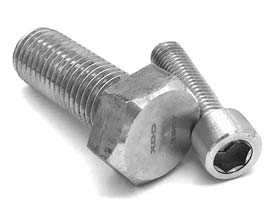The Resilience of 310 Stainless Steel Bolts
Introduction
In the realm of industrial fasteners, the choice of material is paramount to ensuring structural integrity and longevity. Among the plethora of alloys available, 310 stainless steel bolts emerge as a formidable choice, celebrated for their exceptional heat resistance, corrosion resilience, and mechanical strength. This article takes a deep dive into the characteristics, applications, and advantages of 310 stainless steel bolts, shedding light on why they are pivotal components in diverse engineering fields.
Understanding 310 Stainless Steel
310 stainless steel belongs to the family of austenitic stainless steels, renowned for their corrosion resistance and high-temperature strength. The composition of 310 stainless steel includes significant amounts of chromium and nickel, along with smaller additions of manganese and silicon. The alloy’s impressive heat resistance and oxidation tolerance make it a stalwart contender in applications where exposure to extreme temperatures is a constant.
Properties of 310 Stainless Steel
- High Temperature Resistance: A hallmark feature of 310 stainless steel is its capacity to withstand high temperatures. This resilience is attributed to the alloy’s chromium and nickel content, which forms a protective oxide layer at elevated temperatures, preventing degradation and maintaining the material’s mechanical properties.
- Corrosion Resistance: 310 stainless steel exhibits excellent corrosion resistance, particularly in mildly corrosive environments. While not as resistant as austenitic stainless steels in certain corrosive conditions, it is well-suited for applications where elevated temperatures and heat-related corrosion are prevalent.
- Strength and Durability: The alloy offers robust mechanical properties, including high tensile strength and durability. This strength, combined with its heat resistance, positions 310 stainless steel as a reliable choice for components in industries subject to demanding conditions.
- Scaling Resistance: Scaling, a common challenge in high-temperature environments, is effectively mitigated by 310 stainless steel. The alloy’s scaling resistance ensures that it maintains its structural integrity even in conditions where scaling could compromise the material.
- Weldability and Formability: 310 stainless steel retains good weldability and formability, allowing for ease of fabrication in various applications. This versatility enhances its utility in industries that demand complex and customized components.
Applications of 310 Stainless Steel Bolts
- Heat Treatment Furnaces: The exceptional heat resistance of 310 stainless steel makes it a preferred choice for bolts in heat treatment furnaces. These bolts play a critical role in maintaining the structural integrity of furnaces used for processes such as annealing and tempering.
- Aerospace Components: The high-temperature performance and strength of 310 stainless steel find applications in the aerospace industry. Bolts made from this alloy are utilized in the construction of aircraft engines, where they must endure extreme temperatures and corrosive conditions.
- Power Generation Plants: Bolts in close proximity to high-temperature components in power generation plants benefit from the heat-resistant properties of 310 stainless steel. These bolts contribute to the structural integrity of boilers, turbines, and other critical equipment.
- Chemical Processing Equipment: In the chemical industry, where exposure to corrosive substances is prevalent, 310 stainless steel bolts are used in the construction of chemical processing equipment. They withstand the challenges posed by harsh chemicals and high temperatures.
- Oil and Gas Installations: The oil and gas industry, with its demanding conditions and high temperatures, relies on 310 stainless steel bolts in critical connections. These bolts are employed in offshore drilling platforms, pipelines, and processing facilities.
- Automotive Exhaust Systems: The corrosion resistance and high-temperature performance of 310 stainless steel make it a suitable material for bolts in automotive exhaust systems. These bolts endure the corrosive effects of exhaust gases and the elevated temperatures associated with engine operation.
- Furnace and Kiln Components: In industries that involve furnaces and kilns, such as the metallurgical and ceramics sectors, 310 stainless steel bolts are used to fasten components that operate in extreme heat. The alloy’s resilience ensures the stability of these critical components.
- Petrochemical Industry: Bolts in the petrochemical industry, exposed to aggressive chemicals and high temperatures, are often made from 310 stainless steel. This ensures the reliability and longevity of connections in petrochemical processing plants.
- Automotive Engine Components: Within automotive engines, especially in areas prone to high temperatures, 310 stainless steel bolts contribute to the secure assembly of critical components. Their ability to withstand heat and corrosive conditions is crucial for engine performance.
- Nuclear Power Plants: The corrosion resistance and high-temperature tolerance of 310 stainless steel position it as a material of choice in nuclear power plants. Bolts made from this alloy contribute to the stability and reliability of components in these sensitive environments.
Advantages of 310 Stainless Steel Bolts
- Exceptional Heat Resistance: The standout advantage of 310 stainless steel bolts is their exceptional heat resistance, allowing them to maintain strength and integrity in high-temperature environments.
- Corrosion Resistance: The alloy’s resistance to corrosion, especially at elevated temperatures, ensures the longevity of bolts in applications where exposure to corrosive elements is common.
- Strength and Durability: 310 stainless steel bolts exhibit high tensile strength and durability, providing a reliable and long-lasting solution for critical fastening applications.
- Scaling Resistance: The scaling resistance of 310 stainless steel prevents the formation of scale, maintaining the structural integrity of the material in demanding conditions.
- Versatility in Applications: The versatility of 310 stainless steel bolts allows them to be employed in a diverse range of applications, from aerospace engineering to chemical processing, highlighting the adaptability of this material.
Conclusion
In conclusion, 310 stainless steel bolts stand as robust and resilient components in various industries, thanks to their exceptional heat resistance, corrosion resilience, and mechanical strength. From their role in heat treatment furnaces to applications in aerospace, power generation, and chemical processing, these bolts play a crucial part in ensuring the stability and reliability of structures and systems.
As industries continue to demand materials that can withstand extreme conditions, the significance of 310 stainless steel bolts is poised to grow. Their unique combination of properties positions them as crucial components in critical fastening applications, exemplifying the strength and resilience required in modern engineering.
